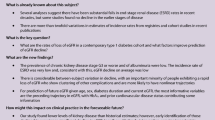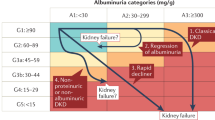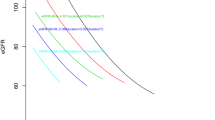Abstract
Impaired renal function and end-stage renal disease (ESRD) affect up to a third of patients with type 1 diabetes. Thus, strategies for early detection and for preventative interventions are of critical importance. A model of diabetic nephropathy was developed in the 1980s that placed paramount importance on the finding of microalbuminuria as an early marker of a committed process of progressive kidney disease in diabetes. However, recent studies have provided evidence that microalbuminuria is a marker of dynamic, rather than fixed, kidney injury. Preliminary studies into early renal function decline, a process measured in early nephropathy using a simple assay for cystatin C to calculate the slope of glomerular filtration rate change over time, suggest that it is a more proximal marker than microalbuminuria of a person’s trajectory toward impaired renal function and ESRD. Therefore, early renal function decline, rather than microalbuminuria, may be considered as the early marker of the committed process underlying progressive diabetic nephropathy.
Similar content being viewed by others
References and Recommended Reading
Krolewski M, Eggers PW, Warram JH: Magnitude of end-stage renal disease in IDDM: a 35-year follow-up study. Kidney Int 1996, 50:2041–2046.
Mogensen CE, Christensen CK: Predicting diabetic nephropathy in insulin-dependent patients. N Engl J Med 1984, 311:89–93.
Parving HH, Oxenboll B, Svendsen PA, et al.: Early detection of patients at risk of developing diabetic nephropathy. A longitudinal study of urinary albumin excretion. Acta Endocrinol (Copenh) 1982, 100:550–555.
Viberti GC, Jarrett RJ, Keen H: Microalbuminuria as prediction of nephropathy in diabetics. Lancet 1982, 2:611.
Caramori ML, Fioretto P, Mauer M: The need for early predictors of diabetic nephropathy risk: is albumin excretion rate sufficient? Diabetes 2000, 49:1399–1408.
Giorgino F, Laviola L, Cavallo Perin P, et al.: Factors associated with progression to macroalbuminuria in microalbuminuric type 1 diabetic patients: the EURODIAB Prospective Complications Study. Diabetologia 2004, 47:1020–1028.
Mauer M, Drummond K: The early natural history of nephropathy in type 1 diabetes: I. Study design and baseline characteristics of the study participants. Diabetes 2002, 51:1572–1579.
Gerstein HC, Mann JF, Yi Q, et al.: Albuminuria and risk of cardiovascular events, death, and heart failure in diabetic and nondiabetic individuals. JAMA 2001, 286:421–426.
Dinneen SF, Gerstein HC: The association of microalbuminuria and mortality in non-insulin-dependent diabetes mellitus. A systematic overview of the literature. Arch Intern Med 1997, 157:1413–1418.
Agewall S, Wikstrand J, Ljungman S, Fagerberg B: Usefulness of microalbuminuria in predicting cardiovascular mortality in treated hypertensive men with and without diabetes mellitus. Risk Factor Intervention Study Group. Am J Cardiol 1997, 80:164–169.
Klausen K, Borch-Johnsen K, Feldt-Rasmussen B, et al.: Very low levels of microalbuminuria are associated with increased risk of coronary heart disease and death independently of renal function, hypertension, and diabetes. Circulation 2004, 110:32–35.
Arnlov J, Evans JC, Meigs JB, et al.: Low-grade albuminuria and incidence of cardiovascular disease events in nonhypertensive and nondiabetic individuals: the Framingham Heart Study. Circulation 2005, 112:969–975.
Tabaei BP, Al-Kassab AS, Ilag LL, et al.: Does microalbuminuria predict diabetic nephropathy? Diabetes Care 2001, 24:1560–1566.
Perkins BA, Ficociello LH, Silva KH, et al.: Regression of microalbuminuria in type 1 diabetes. N Engl J Med 2003, 348:2285–2293. This long-term observational study provides the novel finding that dispels microalbuminuria as a marker of a committed step toward progressive renal injury in type 1 diabetes. Rather, microalbuminuria frequently regresses, and a set of strong determinants for this process of repair exists.
Araki S, Haneda M, Sugimoto T, et al.: Factors associated with frequent remission of microalbuminuria in patients with type 2 diabetes mellitus. Diabetes 2005, 54:2983–2987. By analogy to type 1 diabetes, this long-term observational study of patients with type 2 diabetes conducted in Shiga, Japan, confirms the findings seen in Perkins et al. [14••].
Stockand JD, Sansom SC: Regulation of filtration rate by glomerular mesangial cells in health and diabetic renal disease. Am J Kidney Dis 1997, 29:971–981.
Kitamura M, Fine LG: The concept of glomerular self-defense. Kidney Int 1999, 55:1639–1671.
Raats CJ, Van Den Born J, Berden JH: Glomerular heparan sulfate alterations: mechanisms and relevance for proteinuria. Kidney Int 2000, 57:385–400.
Oldfield MD, Bach LA, Forbes JM, et al.: Advanced glycation end products cause epithelial-myofibroblast transdifferentiation via the receptor for advanced glycation end products (RAGE). J Clin Invest 2001, 108:1853–1863.
Mathiesen ER, Hommel E, Giese J, Parving HH: Efficacy of captopril in postponing nephropathy in normotensive insulin dependent diabetic patients with microalbuminuria. BMJ 1991, 303:81–87.
Viberti G, Mogensen CE, Groop LC, Pauls JF: Effect of captopril on progression to clinical proteinuria in patients with insulin-dependent diabetes mellitus and microalbuminuria. European Microalbuminuria Captopril Study Group. JAMA 1994, 271:275–279.
Laffel LM, McGill JB, Gans DJ: The beneficial effect of angiotensin-converting enzyme inhibition with captopril on diabetic nephropathy in normotensive IDDM patients with microalbuminuria. North American Microalbuminuria Study Group. Am J Med 1995, 99:497–504.
Randomised placebo-controlled trial of lisinopril in normotensive patients with insulin-dependent diabetes and normoalbuminuria or microalbuminuria. The EUCLID Study Group [no authors listed]. Lancet 1997, 349:1787–1792.
Molitch ME, DeFronzo RA, Franz MJ, et al.: Nephropathy in diabetes. Diabetes Care 2004, 27(ppl 1):S79-S83.
Forsblom CM, Groop PH, Ekstrand A, Groop LC: Predictive value of microalbuminuria in patients with insulin-dependent diabetes of long duration. BMJ 1992, 305:1051–1053.
Rudberg S, Persson B, Dahlquist DG: Increased glomerular filtration rate as a predictor of diabetic nephropathyan 8-year prospective study. Kidney Int 1992, 41:822–828.
Ficociello LH, Perkins BA, Silva KH, et al.: Progression from microalbuminuria to proteinuria in individuals with type 1 diabetes treated with angiotensin converting enzyme inhibitors. Diabetes Care 2005, in press.
Warram JH, Scott LJ, Hanna LS, et al.: Progression of microalbuminuria to proteinuria in type 1 diabetes: nonlinear relationship with hyperglycemia. Diabetes 2000, 49:94–100.
Effect of intensive therapy on the development and progression of diabetic nephropathy in the Diabetes Control and Complications Trial. The Diabetes Control and Complications (DCCT) Research Group [no authors listed]. Kidney Int 1995, 47:1703–1720.
Lewis EJ, Hunsicker LG, Bain RP, Rohde RD: The effect of angiotensin-converting-enzyme inhibition on diabetic nephropathy. The Collaborative Study Group. N Engl J Med 1993, 329:1456–1462.
O’Hare P, Bilbous R, Mitchell T, et al.: Low-dose ramipril reduces microalbuminuria in type 1 diabetic patients without hypertension: results of a randomized controlled trial. Diabetes Care 2000, 23:1823–1829.
Crepaldi G, Carta Q, Deferrari G, et al.: Effects of lisinopril and nifedipine on the progression to overt albuminuria in IDDM patients with incipient nephropathy and normal blood pressure. The Italian Microalbuminuria Study Group in IDDM. Diabetes Care 1998, 21:104–110.
Jones CA, Krolewski AS, Rogus J, et al.: Epidemic of end-stage renal disease in people with diabetes in the United States population: do we know the cause? Kidney Int 2005, 67:1684–1691.
Bojestig M, Karlberg BE, Lindstrom T, Nystrom FH: Reduction of ACE activity is insufficient to decrease microalbuminuria in normotensive patients with type 1 diabetes. Diabetes Care 2001, 24:919–924.
Zeller K, Whittaker E, Sullivan L, et al.: Effect of restricting dietary protein on the progression of renal failure in patients with insulin-dependent diabetes mellitus. N Engl J Med 1991, 324:78–84.
Biesenbach G, Janko O, Zazgornik J: Similar rate of progression in the predialysis phase in type I and type II diabetes mellitus. Nephrol Dial Transplant 1994, 9:1097–1102.
Ellis D, Lloyd C, Becker DJ, et al.: The changing course of diabetic nephropathy: low-density lipoprotein cholesterol and blood pressure correlate with regression of proteinuria. Am J Kidney Dis 1996, 27:809–818.
Hovind P, Rossing P, Tarnow L, et al.: Progression of diabetic nephropathy. Kidney Int 2001, 59:702–709.
Dahlquist G, Stattin EL, Rudberg S: Urinary albumin excretion rate and glomerular filtration rate in the prediction of diabetic nephropathy; a long-term follow-up study of childhood onset type-1 diabetic patients. Nephrol Dial Transplant 2001, 16:1382–1386.
Amin R, Turner C, van Aken S, et al.: The relationship between microalbuminuria and glomerular filtration rate in young type 1 diabetic subjects: the Oxford Regional Prospective Study. Kidney Int 2005, 68:1740–1749. This large-scale study of subjects with type 1 diabetes followed from diagnosis demonstrates that early in the course of type 1 diabetes renal function declines significantly, despite remaining in the normal range of GFR. This observation supports a hypothesis that a process of early renal function decline begins in early nephropathy.
Lindeman RD, Tobin J, Shock NW: Longitudinal studies on the rate of decline in renal function with age. J Am Geriatr Soc 1985, 33:278–285.
Hsu CY, Chertow GM, Curhan GC: Methodological issues in studying the epidemiology of mild to moderate chronic renal insufficiency. Kidney Int 2002, 61:1567–1576.
K/DOQI clinical practice guidelines for chronic kidney disease: evaluation, classification, and stratification [no authors listed]. Am J Kidney Dis 2002, 39(2 suppl 1):S1–S266.
Price CP, Finney H: Developments in the assessment of glomerular filtration rate. Clin Chim Acta 2000, 297:55–66.
Massey D: Commentary: clinical diagnostic use of cystatin C. J Clin Lab Anal 2004, 18:55–60.
Newman DJ: Cystatin C. Ann Clin Biochem 2002, 39(Pt 2):89–104.
Mussap M, Ruzzante N, Varagnolo M, Plebani M: Quantitative automated particle-enhanced immunonephelometric assay for the routinary measurement of human cystatin C. Clin Chem Lab Med 1998, 36:859–865.
Tan GD, Lewis AV, James TJ, et al.: Clinical usefulness of cystatin C for the estimation of glomerular filtration rate in type 1 diabetes: reproducibility and accuracy compared with standard measures and iohexol clearance. Diabetes Care 2002, 25:2004–2009.
Shlipak MG, Sarnak MJ, Katz R, et al.: Cystatin C and the risk of death and cardiovascular events among elderly persons. N Engl J Med 2005, 352:2049–2060.
Perkins BA, Nelson RG, Ostrander BE, et al.: Detection of renal function decline in patients with diabetes and normal or elevated GFR by serial measurements of serum cystatin C concentration: results of a 4-year follow-up study. J Am Soc Nephrol 2005, 16:1404–1412. This 4-year observational study of cystatin C as a marker of renal function provides a major technical advance for the study of GFR change over time in the diabetes population in which hyperfiltration is very common. Unlike gold-standard inert substance clearance methods such as iothalamate, which are burdensome for large-scale studies, and unlike creatinine-based estimates, which are inaccurate unless the GFR is low, cystatin C in this study is demonstrated to accurately identify early renal function decline in patients with diabetes.
Perkins BA, Ficociello LH, Palecek B, et al.: Renal function decline occurs soon after the onset of microalbuminuria in type 1 diabetes [abstract]. Diabetes 2003, 52(ppl 1):A189.
Placha G, Canani LH, Warram JH, Krolewski AS: Evidence for different susceptibility genes for proteinuria and ESRD in type 2 diabetes. Adv Chronic Kidney Dis 2005, 12:155–169.
Meier M, Kaiser T, Herrmann A, et al.: Identification of urinary protein pattern in type 1 diabetic adolescents with early diabetic nephropathy by a novel combined proteome analysis. J Diabetes Complications 2005, 19:223–232.
Perkins BA, Ficociello LH, Warram JH, Krolewski AS: Progressive microalbuminuria occurs in parallel with renal function decline in type 1 diabetes without evidence for a causal relationship [abstract]. Diabetes 2005, 54(ppl 1):A549.
Niewczas M, Wolkow P, Lipinski B, et al.: Inflammation and renal function decline in patients with type 1 diabetes mellitus and microalbuminuria [abstract]. J Am Soc Nephrol 2005, in press.
Scott LJ, Warram JH, Hanna LS, et al.: A nonlinear effect of hyperglycemia and current cigarette smoking are major determinants of the onset of microalbuminuria in type 1 diabetes. Diabetes 2001, 50:2842–2849.
Ritz E: Albuminuria and vascular damage—the vicious twins. N Engl J Med 2003, 348:2349–2352.
Author information
Authors and Affiliations
Rights and permissions
About this article
Cite this article
Perkins, B.A., Krolewski, A.S. Early nephropathy in type 1 diabetes: A new perspective on who will and who will not progress. Curr Diab Rep 5, 455–463 (2005). https://doi.org/10.1007/s11892-005-0055-7
Issue Date:
DOI: https://doi.org/10.1007/s11892-005-0055-7




